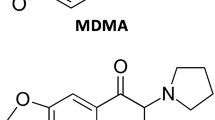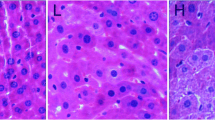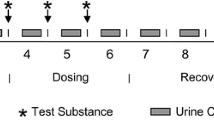Abstract
Trichloroethylene (TCE)-induced liver toxicity and carcinogenesis is believed to be mediated in part by activation of the peroxisome proliferator-activated receptor α (PPARα). However, the contribution of the two TCE metabolites, dichloroacetate (DCA) and trichloroacetate (TCA) to the toxicity of TCE, remains unclear. The aim of the present study was to determine the metabolite profiles in serum and urine upon exposure of mice to TCE, to aid in determining the metabolic response to TCE exposure and the contribution of DCA and TCA to TCE toxicity. C57BL/6 mice were administered TCE, TCA, or DCA, and urine and serum subjected to ultra-performance liquid chromatography coupled with electrospray ionization quadrupole time-of-flight mass spectrometry (UPLC-ESI-QTOFMS)-based global metabolomics analysis. The ions were identified through searching metabolomics databases and by comparison with authentic standards, and quantitated using multiple reactions monitoring. Quantitative polymerase chain reaction of mRNA, biochemical analysis, and liver histology were also performed. TCE exposure resulted in a decrease in urine of metabolites involved in fatty acid metabolism, resulting from altered expression of PPARα target genes. TCE treatment also induced altered phospholipid homeostasis in serum, as revealed by increased serum lysophosphatidylcholine 18:0 and 18:1, and phosphatidylcholine metabolites. TCA administration revealed similar metabolite profiles in urine and serum upon TCE exposure, which correlated with a more robust induction of PPARα target gene expression associated with TCA than DCA treatment. These data show the metabolic response to TCE exposure and demonstrate that TCA is the major contributor to TCE-induced metabolite alterations observed in urine and serum.









Similar content being viewed by others
Abbreviations
- Acaa1a:
-
Acetyl-CoA acyltransferase 1a
- Acadl:
-
Acyl-CoA dehydrogenase, long chain
- Acadm:
-
Acyl-CoA dehydrogenase, C-4 to C-12 straight chain
- Acox:
-
Acyl-CoA oxidase
- Acot1:
-
Acyl-CoA thioesterase 1
- ALT:
-
Alanine transaminase
- ALP:
-
Alkaline phosphatase
- AST:
-
Aspartate aminotransferase
- Cpt1a:
-
Carnitine palmitoyltransferase 1a
- Cpt2:
-
Carnitine palmitoyltransferase 2
- Cyp4a10:
-
Cytochrome P450 4a10
- DCA:
-
Dichloroacetate
- eEF:
-
Eukaryotic translation elongation factor
- Ehhadh:
-
Enoyl-CoA hydratase/3-hydroxyacyl CoA dehydrogenase
- IACR:
-
International Agency for Cancer Research
- LPC:
-
Lysophosphatidylcholine
- MS:
-
Mass spectrometry
- NMR:
-
Nuclear magnetic resonance
- PC:
-
Phosphatidylcholine
- PP:
-
Peroxisome proliferator chemicals
- PPAR:
-
Peroxisome proliferator-activated receptor
- qPCR:
-
Quantitative polymerase chain reaction
- TAF:
-
Template-activating factor
- TCA:
-
Trichloroacetate
- TCE:
-
Trichloroethylene
- TG:
-
Triglyceride
- UPLC:
-
Ultra-performance liquid chromatography
- Wy-14,643:
-
[4-chloro-6-(2,3-xylidino)-2-pyrimidinylthio]acetic acid
References
Bakke B, Stewart PA, Waters MA (2007) Uses of and exposure to trichloroethylene in US industry: a systemic literature review. J Occup Environ Hyg 4(5):375–390
Bull RJ (2000) Mode of action of liver tumor induction by trichloroethylene and its metabolites, trichloroacetate and dichloroacetate. Environ Health Perspect 108(Suppl2):241–259
Bull RJ, Orner GA, Cheng RS, Stillwell L, Stauber AJ, Sasser LB, Lingohr MK, Thrall BD (2002) Contribution of dichloroacetate and trichloroacetate to liver tumor induction in mice by trichloroethylene. Toxicol Appl Pharmacol 182:55–65
Byers VS, Levin AS, Ozonoff DM, Baldwin RW (1988) Association between clinical symptoms and lymphocyte abnormalities in a population with chronic domestic exposure to industrial solvent contaminated domestic water supply and a high incidence of leukaemia. Cancer Immunol Immunother 27(1):77–81
Candura SM, Faustman EM (1991) Trichloroethylene: toxicology and health hazards. G Ital Med Lav 13(1–6):17–25
Corton JC (2008) Evaluation of the role of peroxisome proliferator-activated receptor α (PPARα) in mouse liver tumor induction by trichloroethylene and metabolites. Crit Rev Toxicol 38:857–875
Elcombe CR, Rose MS, Pratt IS (1985) Biochemical, histological, and ultrastructural changes in rat and mouse liver following the administration of trichloroethylene: possible relevance to species differences in hepatocarcinogenicity. Toxicol Appl Pharmacol 67:392–401
Evans MV, Chiu WA, Okino MS, Caldwell JC (2009) Development of an updated PBPK model for trichloroethylene and metabolites in mice, and its application to discern the role of oxidative metabolism in TCE-induced hepatomegaly. Toxicol Appl Pharmacol 236:329–340
Griffin JM, Gilbert KM, Lamps LW, Pumford NR (2000) CD4 + T cell activation and induction of autoimmune hepatitis following trichloroethylene treatment in MRL +/+ mice. Toxicol Sci 57:345–352
Hong WX, Yang L, Chen M, Yang X, Ren X, Fang S, Ye J, Huang H, Peng C, Zhou L, Huang X, Yang F, Wu D, Zhuang Z, Liu J (2012) Proteomic analysis of trichloroethylene-induced alterations in expression, distribution, and interactions of SET/TAF-Ia and two SET/TAF-Ia-binding proteins, eEF1A1 and eEF1A2, in hepatic L-02 cells. Toxicol Appl Pharmacol 263(2):259–272
Johnson CH, Gonzalez FJ (2011) Challenges and opportunities of metabolomics. J Cell Physiol 227(8):2975–2981
Keshava N, Caldwell JC (2006) Key issues in the role of peroxisome proliferator-activated receptor agonism and cell signaling in trichloroethylene toxicity. Environ Health Perspect 114(9):1464–1470
Kim D, Ghanayem BI (2006) Comparative metabolism and disposition of trichloroethylene in Cyp2e1-/- and wild-type mice. Drug Metab Dispos 34(12):2020–2027
Kind T, Fiehn O (2007) Seven Golden Rules for heuristic filtering of molecular formulas obtained by accurate mass spectrometry. BMC Bioinformatics 8:105
Larson JL, Bull RJ (1992) Metabolism and lipoperoxidative activity of trichloroethylene and dichloroacetate in rats and mice. Toxicol Appl Pharmacol 115:268–277
Laughter AR, Dunn CS, Swanson CL, Howroyd P (2004) Role of the peroxisome proliferator-activated receptor a (PPARa) in responses to trichloroethylene and metabolites, trichloroacetate and dichloroacetate in mouse liver. Toxicology 203:83–98
Lee JW, Yamamoto T, Uchikata T, Matsubara A, Fukusaki E, Bamba T (2011) Development of a polar lipid profiling method by supercritical fluid chromatography/mass spectrometry. J Sep Sci 34:3553–3560
Li F, Patterson AD, Höfer CC, Krausz KW, Gonzalez FJ, Idle JR (2011a) A comprehensive understanding of thioTEPA metabolism in the mouse using UPLC–ESI-QTOFMS-based metabolomics. Biochem Pharmacol 81:1043–1053
Li S, Liu H, Jin Y, Lin S, Cai Z, Jiang Y (2011b) Metabolomics study of alcohol-induced liver injury and hepatocellular carcinoma xenografts in mice. J Chromatogr B 879:2369–2375
Li F, Patterson AD, Krausz KW, Tanaka N, Gonzalez FJ (2012) Metabolomics reveals an essential role for peroxisome proliferator-activated receptor alpha in bile acid homeostasis. J Lipid Res 53(8):1625–1635
Liu J, Huang H, Xing X, Xi R, Zhuang Z, Yuan J, Yang F, Zhao J (2007) Comparative proteomic analysis on human L-02 liver cells treated with varying concentrations of trichloroethylene. Toxicol Ind Health 23(2):91–101
Maronpot RR, Anna CH, Devereux TR, Lucier GW, Butterworth BE, Anderson MW (1995) Considerations concerning the murine hepatocarcinogenicity of selected chlorinated hydrocarbons. Prog Clin Biol Res 391:305–323
Matsubara T, Tanaka N, Patterson AD, Cho JY, Krausz KW, Gonzalez FJ (2011) Lithocholic acid disrupts phospholipid and sphingolipid homeostasis leading to cholestasis in mice. Hepatology 53(4):1282–1293
Merdink JL, Gonzalez-Leon A, Bull RJ, Schultz IR (1998) The extent of dichloroacetate formation from trichloroethylene, chloral hydrate, trichloroacetate, and trichloroethanol in B6C3F1 mice. Toxicol Sci 45:33–41
Michalik L, Auwerx J, Berger JP, Chatterjee VK, Glass CK, Gonzalez FJ, Grimaldi PA, Kadowaki T, Lazar MA, O’Rahilly S, Palmer CN, Plutzky J, Reddy JK, Spiegelman BM, Staels B, Wahli W (2006) International union of pharmacology. LXI peroxisome proliferator-activated receptors. Pharmacol Rev 58(4):726–741
Nakajima T, Kamijo Y, Usuda N, Liang Y, Fukushima Y, Kametani K, Gonzalez FJ, Aoyama T (2000) Sex-dependent regulation of hepatic peroxisome proliferation in mice by trichloroethylene via peroxisome proliferator-activated receptor α (PPARα). Carcinogenesis 21(4):677–682
Park SK, Nam SW, Ryu JC, Ham JH, Lee MY (2010) Proteomic analysis of rat liver proteins differentially induced by trichloroethylene. Biochip J 4(1):57–62
Patterson AD, Slanar O, Krausz KW, Li F, Höfer CC, Perlík F, Gonzalez FJ, Idle JR (2009) Human urinary metabolomic profile of PPARa induced fatty acid β-oxidation. J Proteome Res 8:4293–4300
Pesch B, Haerting J, Ranft U, Klimpel A, Oelschlägel B, Schill W (2000) Occupational risk factors for renal cell carcinoma: agent-specific results from a case-control study in Germany, MURC Study Group. Multicenter urothelial and renal cancer study. Int J Epidemiol 29(6):1014–1024
Ramdhan DH, Kamijima M, Yamada N, Ito Y, Yanagiba Y, Nakamura D, Okamura A, Ichihara G, Aoyama T, Gonzalez FJ, Nakajima T (2008) Molecular mechanism of trichloroethylene-induced hepatotoxicity mediated by CYP2E1. Toxicol Appl Pharmacol 231(3):300–307
Ramdhan DH, Kamijima M, Wang D, Ito Y, Naito H, Yanagiba Y, Hayashi Y, Tanaka N, Aoyama T, Gonzalez FJ, Nakajima T (2010) Differential response to trichloroethylene-induced hepatosteatosis in wild-type and PPARα-humanized mice. Environ Health Perspect 118(11):1557–1563
Tan Y, Yin P, Tang L, Xing W, Huang Q, Cao D, Zhao X, Wang W, Lu X, Xu Z, Wang H, Xu G (2012) Metabolomics study of stepwise hepatocarcinogenesis from the model rats to patients: potential biomarkers effective for small hepatocellular carcinoma diagnosis. Mol Cell Proteomics 11(2): DOI: 10.1074/mcp.M111.010694
Tanaka N, Moriya K, Kiyosawa K, Koike K, Gonzalez FJ, Aoyama T (2008) PPARalpha activation is essential for HCV core protein-induced hepatic steatosis and hepatocellular carcinoma in mice. J Clin Invest 118:683–694
Tanaka N, Matsubara T, Krausz KW, Patterson AD, Gonzalez FJ (2012) Disruption of phospholipid and bile acid homeostasis in mice with nonalcoholic steatohepatitis. Hepatology 56(1):118–129
Templin MV, Parker JC, Bull RJ (1993) Relative formation of dichloroacetate and trichloroacetate from trichloroethylene in male B6C3F1 mice. Toxicol Appl Pharmacol 123:1–8
Templin MV, Stevens DK, Stenner RD, Bonate PL, Tuman D, Bull RJ (1995) Factors affecting species differences in the kinetics of metabolites of trichloroethylene. J Tocicol Environ Health 44:435–447
Viant MR, Bundy JG, Pincetich CA, de Ropp JS, Tjeerdema RS (2005) NMR-derived developmental metabolic trajectories: an approach for visualizing the toxic actions of trichloroethylene during embryogenesis. Metabolomics 1(2):149–158
Wartenberg D, Reyner D, Scott CS (2000) Trichloroethylene and cancer: epidemiologic evidence. Environ Health Perspect 108(Suppl. 2):161–176
Zhen Y, Krausz KW, Chen C, Idle JR, Gonzalez FJ (2007) Metabolomic and genetic analysis of biomarkers for peroxisome proliferator-activated receptor a expression and activation. Mol Endocrinol 21(9):2136–2151
Zhou YC, Waxman DJ (1998) Activation of peroxisome proliferator-activated receptors by chlorinated hydrocarbons and endogenous steroids. Environ Health Perspect 106(Suppl 4):983–988
Acknowledgments
This work was supported in part by the Intramural Research Program of the Center for Cancer Research, National Cancer Institute, National Institutes of Health.
Conflict of interest
The authors have declared that there are no conflicts of interest.
Author information
Authors and Affiliations
Corresponding author
Electronic supplementary material
Below is the link to the electronic supplementary material.
Rights and permissions
About this article
Cite this article
Fang, ZZ., Krausz, K.W., Tanaka, N. et al. Metabolomics reveals trichloroacetate as a major contributor to trichloroethylene-induced metabolic alterations in mouse urine and serum. Arch Toxicol 87, 1975–1987 (2013). https://doi.org/10.1007/s00204-013-1053-1
Received:
Accepted:
Published:
Issue Date:
DOI: https://doi.org/10.1007/s00204-013-1053-1




